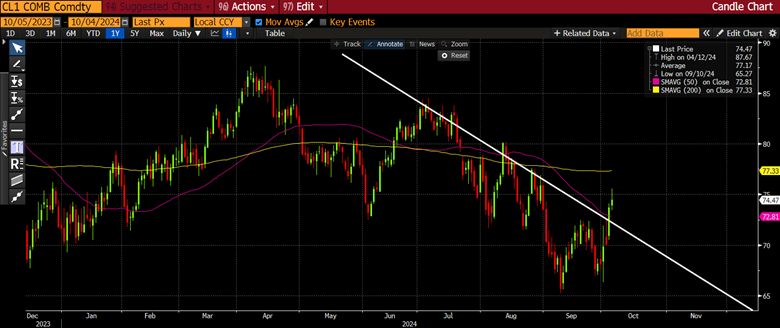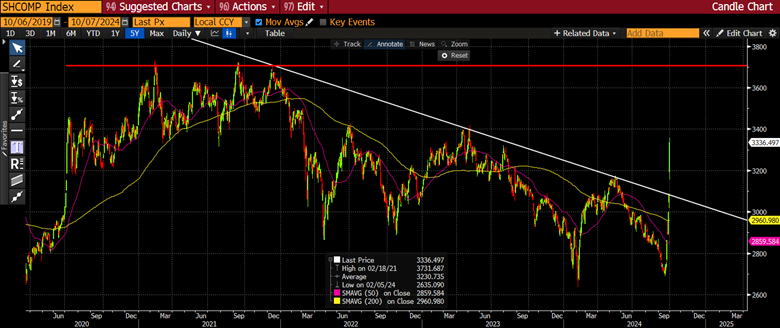Decade in a Week — Week of October 7, 2024

| index | wtd | ytd | 1-year | 3-year | 5-year | index level |
|---|---|---|---|---|---|---|
| S&P 500 Index | 0.26 | 21.86 | 37.01 | 11.49 | 16.09 | 5,751.07 |
| Dow Jones Industrial Average | 0.13 | 14.03 | 30.42 | 9.49 | 12.07 | 42,352.75 |
| Russell 2000 Small Cap | - 0.48 | 10.32 | 29.65 | 1.19 | 9.50 | 2,197.47 |
| NASDAQ Composite | 0.12 | 21.51 | 38.30 | 8.81 | 18.82 | 18,137.85 |
| MSCI Europe, Australasia & Far East | - 3.73 | 11.01 | 25.60 | 5.59 | 8.72 | 2,413.03 |
| MSCI Emerging Markets | 0.42 | 17.99 | 30.41 | 1.44 | 6.33 | 1,179.34 |
| Barclays U.S. Aggregate Bond Index | - 1.24 | 3.40 | 11.33 | - 1.70 | - 0.02 | 2,235.47 |
| Merrill Lynch Intermediate Municipal | - 0.03 | 2.02 | 9.09 | 0.27 | 1.29 | 321.25 |
As of market close . Returns in percent.
Investment Insights
— Steve Orr
Very Different
“There are decades where nothing happens; and there are weeks where decades happen” attributed to Vladimir Lenin.
While we may not agree with Mr. Lenin’s politics, we think he is spot on describing last week. Regular readers know that outside events can shake markets but rarely change the long-term trend. Dare we list every event last week? Let’s settle for a top three. We will start with Friday and see if we can finish before running out of paper.
Flash
Space Weather Watch lists 3 solar flares this past week. The largest, and X9.0 class, should have passed by earth this weekend. The earlier class 7 flare messed with our phone GPS Friday. Solar flares are more common during peaks the sunspot cycle. Radio and GPS signals were disrupted in May and last December due to flares. Markets were closed when the flares hit.
4 to 2
The Iran – Israel war ramped up in the middle of last week. Iran launched the largest ballistic missile attack in history on Tuesday. U.S. and Israeli missile defense systems were able to intercept most of the missiles. Israel responded by killing Hassan Jafar Qassir, Hassan Nasrallah’s son-in-law. This was the first reported aerial bombing in this campaign in Syria. We moved this war up to #2 on our list of global conflicts. Russia invading Ukraine, cyber, space and Africa round out the actives list. Israel’s incursion into southern Lebanon got oil off of its downtrend.
Effect?

The five daily bars jumping higher at the far right of the chart are West Texas Intermediate moving nearly 11% from its September 27 recent low. The white downtrend line extending back to early July shows futures prices dropping some $16 per barrel in the face of weakening demand and plentiful supply. Satellite data shows National Iranian Tanker Company supertankers left Iran’s Kharg Island terminal Wednesday and Thursday. Perhaps they want to preserve their investment.
Note on the chart that prices started moving before the I-I back and forth. A story appeared earlier in the week in the Financial Times suggesting that Saudi Arabia may be changing its revenue goals for oil sales. Over the last year it has pursued a $100 / barrel price objective. Higher prices earlier in the year brought more supply from non-OPEC sources. Oops.
OPEC+ recently pushed to December a decision on whether to increase production. Abandoning the $100 goal would mean the Saudis produce more. After the article came out crude briefly tested that recent low (the long green bar) but stayed above that level. That indicates the Bulls may be in charge. The new “wartime” footing for the oil market should keep prices elevated and give OPEC+ a reason to grab market share by turning up the taps.
National
Worries over Christmas presents abated after the longshoremen agreed to temporarily return to work. The new deadline is mid-January for a strike. The two sticking points are still automation and the number of times a crane grabs a box (the union gets a cut each time). Media reports say that the shippers caved to White House pressure and compromised on a 60% pay raise over six years.
We wonder if it was Governor DeSantis calling out the National Guard to Florida ports hours earlier. Some 20,000 union members rejoiced, while 25,000 of the 45,000 were satisfied, we think. Why that breakdown? The 20k are non-dock workers who are grandfathered at the same wages under prior contracts. The other 25k are the actual dock workers. Welcome to the new standard for labor talks. Wage inflation anyone?
Rockets
Taking a step back into September, we need to review China’s latest stimulus attempt. On the 27th in a joint press conference the central bank, securities regulatory commission and national financial regulatory administration announced a series of rate, policy, and property cuts. Existing mortgages were cut by a half-percent (lets do that here), central bank rates dropped 0.2% and reserve requirements for banks 0.5%. Most important for our portfolios is that CSRC Chair Wu announced a 500B Yaun facility for buying stocks. PBOC Governor Pan said that if 500B was not enough that they would add 500B more. Predictably the onshore market rocketed higher.

We held off telling you this (exciting) news because other events were more pressing last week. Notice that the chart stops at September 30. This is because last week China was closed for National Day. We are very curious to see if the rally holds onshore and extends to offshore stocks. The red line shows the triple top the Shanghai index made in 2021; this is a bearish pattern. Since then, good news about the China economy has been scarce.
Naturally, a rate-of-change in a stock index is going to push our indicator dashboard, and indeed last week we had a buy in emerging markets. Note that these are weekly signals – we usually wait a few weeks to see if a signal will be short-term or more suited to our portfolios as an intermediate change lasting months. Historians among you will remember the last couple of times China stimulated its stock market in late 2015-16 and during shutdowns the stimulus effect lasted less than year.
Circle back
One last Friday item: the BLS Payrolls report. The dry details are September’s estimated job growth was 254,000, nearly double the 150,000 estimate. The biggest gain came in the leisure and hospitality sector, a welcome change from government job growth for most of this year. The unemployment rate ticked down to 4.05% and the U-6 unemployment rate dipped from 7.0% to 7.7%. October’s job number will be weak, thanks to furloughs by automakers, Boeing, and effects of Hurricane Helene.
We argued in the winter and early spring there would be a slowdown. Job and economic growth dipped in the summer but if this job report is indicative of actual conditions, then the economy has bottomed and returned to growth ahead of our thinking. Fine by us. September’s outsized job growth does paint the Fed in an awkward light. Calls for a half point cut in November all but vanished last Friday. We think the Fed sticks with a quarter-point cut in both November and December. Yes, the Fed wants to stick to its narrative. But the case can be made that financial conditions are restrictive. The 10-year Treasury bounced 12 basis points after the job report to yield 3.96%. Two-year Treasuries moved 0.21% (21 basis points) a rare jump. They now yield 3.92%, their highest since late August.
Primary Trend
We mentioned the long-term Secular trend last week. The intermediate trend remains higher for stocks. The S&P 500’s +21% gain through September is the ninth best since 1950, according to Strategas Research. Looking at those nine cases October turns in choppy to down results, but the fourth quarter turns positive. Our indicators look to the intermediate term and are keeping us fully invested.
Momentum post-Fed cut is largely neutral. The market continues to improve away from the mega-tech Magnificent 7. Utilities have done very well the last few months, benefiting from the data center craze. Energy and materials are beginning to stir.
Interest rates turned lower through the summer anticipating the Fed starting the rate cut cycle. Looking longer term we are concerned that (someday) the Administration debt spending will cause rates to rise. The 40-year cycle in lower rates ended in 2020. The new 40-year cycle in higher rates will take time to ramp, but we are biased toward higher rates over the coming years.
Wrap-Up
The recent wave of outside events should have jolted markets off-kilter. We are impressed with the resilience of the dollar, gold, and stocks. Rates jumped because they moved too low, overshooting fair value in anticipating larger Fed cuts than the economy requires. China’s markets will prove interesting in the coming weeks. Stay strapped in for more news and a bumpy October.
Steve Orr is the Managing Director and Chief Investment Officer for Texas Capital Bank Private Wealth Advisors. Steve has earned the right to use the Chartered Financial Analyst and Chartered Market Technician designations. He holds a Bachelor of Arts in Economics from The University of Texas at Austin, a Master of Business Administration in Finance from Texas State University, and a Juris Doctor in Securities from St. Mary’s University School of Law. Follow him on Twitter here.
The contents of this article are subject to the terms and conditions available here.
Texas Capital Private Bank™ refers to the wealth management services offered by the bank and non-bank entities comprising the Texas Capital brand, including Texas Capital Bank Private Wealth Advisors (PWA). Nothing herein is intended to constitute an offer to sell or buy, or a solicitation of an offer to sell or buy securities.
Investing is subject to a high degree of investment risk, including the possible loss of the entire amount of an investment. You should carefully read and review all information provided by PWA, including PWA’s Form ADV, Part 2A brochure and all supplements thereto, before making an investment.
Neither PWA, the Bank nor any of their respective employees provides tax or legal advice. Nothing contained on this website (including any attachments) is intended as tax or legal advice for any recipient, nor should it be relied on as such. Taxpayers should seek advice based on the taxpayer’s particular circumstances from an independent tax advisor or legal counsel. The wealth strategy team at PWA can work with your attorney to facilitate the desired structure of your estate plan. The information contained on this website is not a complete summary or statement of all available data necessary for making an investment decision, and does not constitute a recommendation. The information has been obtained from sources considered to be reliable, but we do not guarantee that the foregoing material is accurate or complete. Any opinions are those of the authors and not necessarily those of PWA or the Bank.
©2025 Texas Capital Bank Wealth Management Services, Inc., a wholly owned subsidiary of Texas Capital Bank. All rights reserved.
Texas Capital Bank Private Wealth Advisors and the Texas Capital Bank Private Wealth Advisors logo are trademarks of Texas Capital Bancshares, Inc., and Texas Capital Bank.
www.texascapitalbank.com Member FDIC NASDAQ®: TCBI